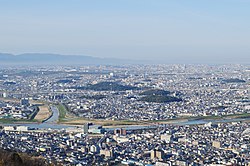Habikino
Habikino
羽曳野市 | |
|---|---|
 Panoramic view of downtown Habikino and Furuichi tomb group heritage site | |
|
Mandarin Orange |

Habikino (羽曳野市, Habikino-shi) is a
Geography
Habikino is located in the southeastern part of Osaka Prefecture, in the Kawachi Plain surrounded by Ikoma, Kongō, and Katsuragi Mountains and Mount Nijō. It is within about 20 kilometers from the center of Osaka metropolis.
Neighboring municipalities
Osaka Prefecture
- Sakai
- Matsubara
- Fujiidera
- Kashiwara
- Tondabayashi
- Taishi
Nara Prefecture
Climate
Habikino has a Humid subtropical climate (Köppen Cfa) characterized by warm summers and cool winters with light to no snowfall. The average annual temperature in Habikino is 14.2 °C. The average annual rainfall is 1475 mm with September as the wettest month. The temperatures are highest on average in August, at around 26.3 °C, and lowest in January, at around 2.7 °C.[2]
Demographics
Per Japanese census data,[3] the population of Habikino increased rapidly from the 1960s through 1990s, and has leveled off since.
| Year | Pop. | ±% |
|---|---|---|
| 1960 | 36,982 | — |
| 1970 | 77,134 | +108.6% |
| 1980 | 103,181 | +33.8% |
| 1990 | 115,049 | +11.5% |
| 2000 | 119,264 | +3.7% |
| 2010 | 117,702 | −1.3% |
History
The area of the modern city of Habikino was within ancient
After the
Government
Habikino has a
Economy
Habikino is a regional commercial center. It was traditionally known for grapes and figs. There is some light manufacturing, but agriculture remains central to the local economy.
Education
Universities and technical schools
- Shitennōji International Buddhist University
- Osaka Prefecture University Habikino Campus (formerly Osaka Prefecture College of Nursing)
Primary and secondary education
Habikino has 13 public elementary schools, five public middle schools and one combined elementary/middle school operated by the city government and one public high school operated by the Osaka Prefectural Department of Education.
Transportation
Railway
- (to Osaka Abenobashi) - Eganoshō - Takawashi - < Fujiidera - Hajinosato - Dōmyōji> Furuichi - Komagatani - Kaminotaishi - (to Kintetsu Gose, Kashiharajingū-mae, Yoshino)
Highway
 Minami-Hanna Road (Habikino Interchange, Habikino-Higashi Interchange)
Minami-Hanna Road (Habikino Interchange, Habikino-Higashi Interchange) National Route 166
National Route 166 National Route 170 (Osaka Outer Loop Highway)
National Route 170 (Osaka Outer Loop Highway)
Bus
- Kintetsu Bus
- From Furuichi Station in the east, buses carry passengers on routes to Habikigaoka, Shitennōji International Buddhist University, Momoyama-dai, and Fujiidera Station.
- From Eganoshō Station in the west, there is a bus route to Kawachi-Matsubara Station which also covers Mihara-ku in Sakai.
- Kongō Bus
- Buses pick up passengers at Kaminotaishi Station.
Local attractions
- Furuichi Kofun Cluster, a group of Kofun.[4] They are recorded as World Heritage Sites.
- Kannonzuka Kofun, National Historic Site
- Honda Shiratori Haniwa Production Site, National Historic Site
- Tsūhō-ji ruins, National Historic Site
- Yachū-ji temple ruins, National Historic Site
Sister city relations
Within Japan
- Mie(friendship city)
- Nara(friendship city)
Internationally
Notable people from Habikino
- Makate Asai, writer
- Yu Darvish, baseball player
- Sayuri Uenishi, politician
- Hiroki Uchi, idol singer, songwriter, actor and model
References
- ^ "Habikino city official statistics" (in Japanese). Japan.
- ^ Habikino climate data
- ^ Habikino population statistics
- ^ "World Heritage Mozu-Furuichi Kofun Group: Mounded Tombs of Ancient Japan". www.mozu-furuichi.jp. Retrieved 2020-04-27.
External links
- Habikino City official website (in Japanese)
